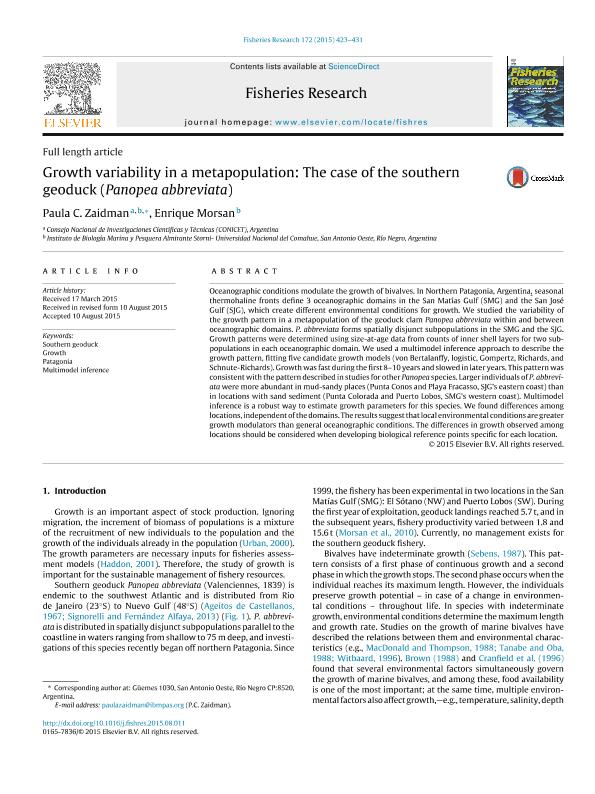Mostrar el registro sencillo del ítem
dc.contributor.author
Zaidman, Paula Cecilia

dc.contributor.author
Morsan, Enrique Mario

dc.date.available
2021-03-08T11:29:26Z
dc.date.issued
2015-12
dc.identifier.citation
Zaidman, Paula Cecilia; Morsan, Enrique Mario; Growth variability in a metapopulation: The case of the southern geoduck (Panopea abbreviata); Elsevier Science; Fisheries Research; 172; 12-2015; 423-431
dc.identifier.issn
0165-7836
dc.identifier.uri
http://hdl.handle.net/11336/127693
dc.description.abstract
Oceanographic conditions modulate the growth of bivalves. In Northern Patagonia, Argentina. , seasonal thermohaline fronts define 3 oceanographic domains in the San Matías Gulf (SMG) and the San José Gulf (SJG), which create different environmental conditions for growth. We studied the variability of the growth pattern in a metapopulation of the geoduck clam Panopea abbreviata within and between oceanographic domains. P. abbreviata forms spatially disjunct subpopulations in the SMG and the SJG. Growth patterns were determined using size-at-age data from counts of inner shell layers for two subpopulations in each oceanographic domain. We used a multimodel inference approach to describe the growth pattern, fitting five candidate growth models (von Bertalanffy, logistic, Gompertz, Richards, and Schnute-Richards). Growth was fast during the first 8-10 years and slowed in later years. This pattern was consistent with the pattern described in studies for other Panopea species. Larger individuals of P. abbreviata were more abundant in mud-sandy places (Punta Conos and Playa Fracasso, SJG's eastern coast) than in locations with sand sediment (Punta Colorada and Puerto Lobos, SMG's western coast). Multimodel inference is a robust way to estimate growth parameters for this species. We found differences among locations, independent of the domains. The results suggest that local environmental conditions are greater growth modulators than general oceanographic conditions. The differences in growth observed among locations should be considered when developing biological reference points specific for each location.
dc.format
application/pdf
dc.language.iso
eng
dc.publisher
Elsevier Science

dc.rights
info:eu-repo/semantics/openAccess
dc.rights.uri
https://creativecommons.org/licenses/by-nc-sa/2.5/ar/
dc.subject
GROWTH
dc.subject
MULTIMODEL INFERENCE
dc.subject
PATAGONIA
dc.subject
SOUTHERN GEODUCK
dc.subject.classification
Ecología

dc.subject.classification
Ciencias Biológicas

dc.subject.classification
CIENCIAS NATURALES Y EXACTAS

dc.title
Growth variability in a metapopulation: The case of the southern geoduck (Panopea abbreviata)
dc.type
info:eu-repo/semantics/article
dc.type
info:ar-repo/semantics/artículo
dc.type
info:eu-repo/semantics/publishedVersion
dc.date.updated
2021-02-26T19:16:32Z
dc.journal.volume
172
dc.journal.pagination
423-431
dc.journal.pais
Países Bajos

dc.journal.ciudad
Amsterdam
dc.description.fil
Fil: Zaidman, Paula Cecilia. Consejo Nacional de Investigaciones Cientificas y Tecnicas. Centro Cientifico Tecnologico Conicet - Patagonia Confluencia. Unidad de Administracion Territorial.; Argentina. Universidad Nacional del Comahue. Instituto de Biología Marina y Pesquera Almirante Storni; Argentina
dc.description.fil
Fil: Morsan, Enrique Mario. Universidad Nacional del Comahue. Instituto de Biología Marina y Pesquera Almirante Storni; Argentina. Consejo Nacional de Investigaciones Científicas y Técnicas; Argentina
dc.journal.title
Fisheries Research

dc.relation.alternativeid
info:eu-repo/semantics/altIdentifier/url/http://www.sciencedirect.com/science/article/pii/S0165783615300576
dc.relation.alternativeid
info:eu-repo/semantics/altIdentifier/doi/https://doi.org/10.1016/j.fishres.2015.08.011
Archivos asociados
